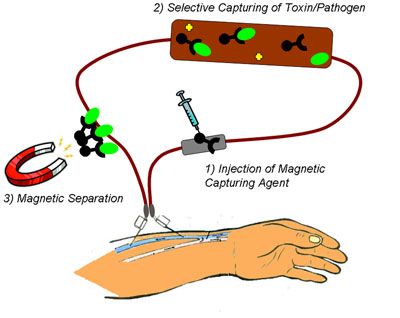Nanomagnets May Mitigate the Need for Dialysis in Removing Pathogens from Blood
Nanomagnet system cleans blood of toxins and pathogens without drawbacks of other blood purification systems
Last week, Nanowerk’s Spotlight piece covered recent research in which Swiss researchers demonstrated that they could remove metal ions, steroid drugs and proteins from blood by using nanomagnets.
The nanomagnets are basically carbon-coated iron carbide at the nanoscale (an average diameter of 30 nanometers) and are functionalized with linker molecules that attract the target material in the blood.
The work comes out of the Functional Materials Laboratory (FML) that was founded in 2004 by Prof. Wendelin J. Stark at ETH Zurich (Swiss Federal Institute of Technology Zurich).
One of Stark’s PhD students, Inge Hermann, was the first author on a paper in the journal Small entitled “Blood Purification Using Functionalized Core/Shell Nanomagnets”.
According to Inge in the Nanowerk piece, the system is capable of selectively removing toxins or pathogens from whole blood within minutes. Among the clearest advantages of this process over other blood purification techniques, such as dialysis and plasma filtration, is its ability to get to substances of different masses and dimensions and it doesn’t suffer from filter cut offs or slow pore diffusion in membranes.
“By using magnetic metal nanomagnets carrying target-specific ligands, we showed that blood purification at a nano- to pico-molar scale is possible," says Prof. Stark in the Nanowerk article.
It seems the researchers have high hopes for the commercial prospects of the process. An ETH spin-out company has already been formed called Turbobeads that will commercialize at least parts of the metal nanomagnet technology.
Dexter Johnson is a contributing editor at IEEE Spectrum, with a focus on nanotechnology.
